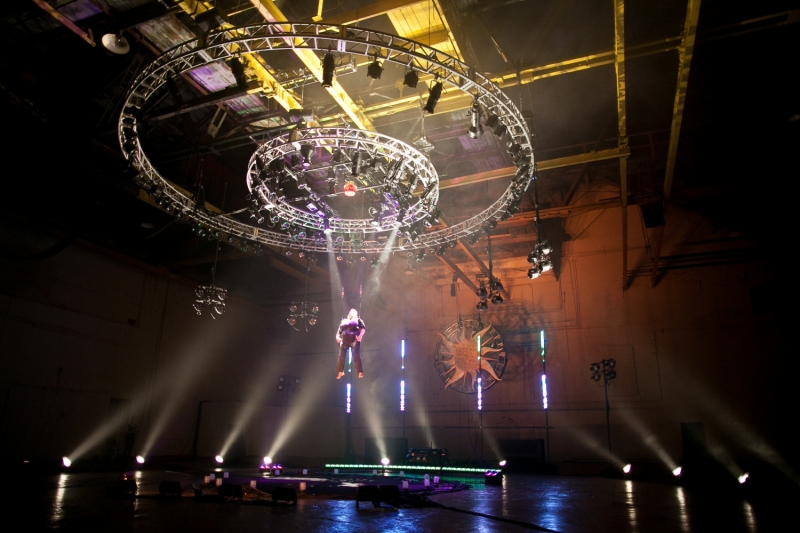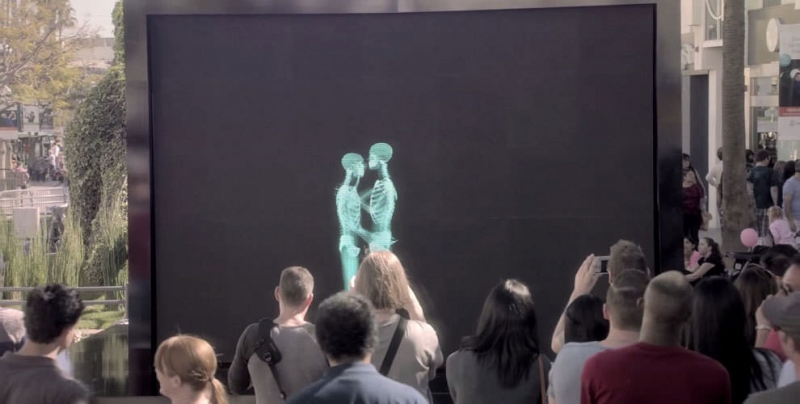(Photo: Love Has No Labels via YouTube)
This series is a deep-dive into the Power of Immersive Experience to facilitate organizational change. Before turning focus to the business world, we wanted to glean insights from the realms of theater and high-tech performance art.
You may remember the powerful “Love Has No Labels” ad campaign that went viral in 2015. It featured skeletons dancing and embracing behind a curtain before emerging from behind the x-ray screen to reveal themselves as diverse pairings of friends, families, and couples. With 160 million views, this video became the second most watched social activism ad of all time.
Michelle Stern, our interviewee, was COO at the company (Mindride LLC) that designed the live experience, production, and technology for the “Love Has No Labels” campaign.
Michelle’s career has straddled the worlds of high-tech production and performance art, avant-garde theater, and corporate events. We had the opportunity to speak with her about what she sees as the defining elements of impactful immersive experiences including storytelling, audience engagement and the role of technology.
Marsha: You began to explore immersive experiences over 20-years ago with GAle GAtes et al, an avant-garde theater company that spearheaded the arts scene in Dumbo, Brooklyn.
Michelle: Our goal was to have the performance surround our audience offering them opportunities to interact with the actors and guide their own experience. We were familiar with how this could work from street performances, but now wanted to design the environment to further enhance audience participation and immersion.
Marsha: What initially drew you to be involved in creating immersive experiences?
Michelle: Delivering immersive experiences offers unique challenges to me as an actor and producer. As a performer, traditional theater can sometimes feel stodgy, while immersive theater is always fresh and exciting. Without the safety of the fourth wall—the built in separation between audience and the stage—you never know what will happen. Most people are supportive but some people mess with you or get scared. As an actor and an audience member you are kept on your toes. This generates terrific energy.
As a producer, immersive theater offers so many puzzles to solve. For example, we wanted to perform on the steps of the Metropolitan Museum of Art and found that they wouldn’t offer permits for performance pieces. However, once I discovered that they would authorize photo shoots we reframed our piece arguing that the little lights we needed to install were set dressing for a photo shoot rather than a performance.
Marsha: Skipping ahead to your work with Mindride, in addition to your involvement in designing Love Has No Labels, you were part of launching The Ascent, a “mind controlled flying experience,” tell us about that.
Michelle: In broad terms, The Ascent is a high-tech art installation/performance piece. The setup is that a rotating volunteer performs in front of an audience. As the performer, your goal is to “fly” to the ceiling. To do this, you strap into a harness and flying lines, don an EEG headset, and try to put your mind into a meditative state. The EEG sensors measure your brain waves and send the data into an automated system, which triggers a winch. If you get into the zone and maintain it, you fly. What is more, everything in the physical environment (sounds, lights, wind, etc.) also reacts to your brainwaves. If you reach the ceiling the “sun” comes out and triumphant music plays.

Credit: The Ascent by xxxy/Mindride © 2013
Photo credit: Andrew Federman
Marsha: And how does the audience fit in?
Michelle: The fact that the flyer is trying to enter a meditative state while being watch creates an exciting dynamic in and of itself. For the audience it is also very suspenseful because each person’s ride is very specific and tells a unique story of confidence, fear, determination, exhilaration, etc.
Marsha: Your work has run the spectrum from wholly analogue to extremely high-tech. What have you learned about the role of technology in immersive experience?
Michelle: It is easy in this day and age to rely on technology to create a powerful immersive experience. The result can be gimmicky and the level of engagement superficial. It is essential that the technology be used in support of the story you want to tell and the message you want to communicate.
The Ascent is a great example because it’s not just a ride; each ascent is a mini play. The audience watches someone struggling with their own ability to succeed, or the fact that they are failing or think they are failing. You could just use the EEG data to help someone go up and down and that would be cool technology, but integrating this data with lighting, sound, and atmospherics helped tell the audience a story about the individual’s mental and spiritual state. For example, the audience is standing on an observation deck with subwoofers underneath. Since the music pulses in accordance with the level of focus achieved by the “flyer,” the audience literally feels their brainwaves. As a result, for the audience it becomes about connecting to the person performing, it is about their story and experience.
Marsha: Love has No Labels had a similar quality.
Michelle: Yes. The technology was very complex to pull off live (we were seriously hustling backstage), but the effect for the audience was to amplify a human story.

(Photo: Love Has No Labels via YouTube)
Marsha: Do you think audience members in an immersive performance connect with one another differently than they do in a traditional performance?
Michelle: In traditional theater, the primary connection is between you and the performers on stage. In immersive theater you can often watch the way that other members of the audience are reacting, what they are interested in, how they are relating to the other people. It has the potential to deepen the experience and create a sense of community for the people that are in the room.
Marsha: Can you give us an example of how the audience bonds through the participatory nature of a performance experience?
Michelle: I just worked on a show called, 24 Decade History of Popular Music by Taylor Mac. Taylor begins the performance with a large band and each hour for 24-hours one person leaves until at the end he is performing by himself. There is no show without the audience and each show is different because of how the audience participates. While this is true of any show, Taylor’s piece ratchets it up many notches. It is a deeply participatory experience for the audience; they dance, they feed each other, they sit with different people on the floor. In addition to collectively shaping the show itself, because of the 24-hour duration of the show there was an endurance component that connected us to one another and created an amazing sense of community. I have since crossed paths with individuals who were at the show and the bond persists.
Marsha: I want to ask you about the definition of an immersive experience.
Michelle: I would say that it has to do with the environment; both the performer and the audience need to inhabit the same space and the delineation of who is who is revealed through the experience. The entire environment is constructed to breakdown the audience-performer paradigm. Agency is also key. Immersive theater and performance art requires a different level of audience engagement to garner the intended experience. The audience helps shape the experience.
Marsha: You also have extensive experience producing large scale corporate and entertainment events as well as awards ceremonies. Do you have any parting words of wisdom for organizations looking to use immersive experience to build community and engagement among their employees and customers? What could set them up for success?
Michelle: I think it is important to remember that powerful immersive experiences are a form of storytelling. The participant experience must follow a trajectory and you must have an end goal or purpose in mind. It is easy to do a lot of gimmicky stuff but if you are going for something deeper and more significant, the “storytelling” experience lends depth and impact. Bringing art and artists into the storytelling process is always great.
I think the reason the business world has gravitated towards storytelling and immersive experience is because of the impact. That impact comes in large part from the fact that people love being part of shaping something, especially when it is good.
Back



